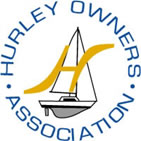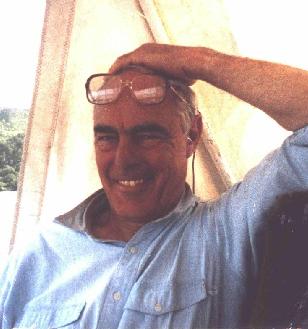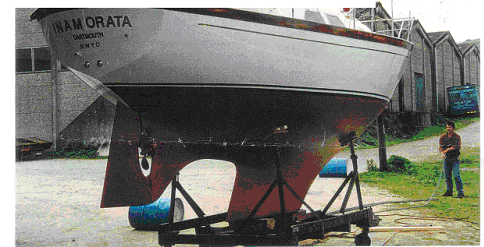


Ian Anderson reflects on a lifetime in yacht design

I was born in Somerset quite a while ago. My father, a Dental Surgeon, thankfully took an enlightened view about my following in his footsteps and I suppose it was his motor boat kept in Poole Harbour which kindled my interest in yachts and boats.
Duly apprenticed to Fred Parker in Poole for 3 years which was great fun and very creative as we were designing and having built some of the top racing yachts under the R.O.R.C. rules of the time - Phizz, Norlethe and such. Looking back now they were so narrow and so heavy by comparison with today's lightweight water ballasted, swinging keel ' surfboard' flyers.
Fred Parker thought after 3 years of me he would let somebody else have the problem and recommended that a spell at Camper and Nicholsons in Southampton might broaden my experience and so I met and was taken on by Charles Nicholson whose' sons Peter and George were also working in the drawing office. Peter had done his National Service in the Fleet Air Arm and I was extremely jealous because flying was what I really wanted to do but I was a touch colour recognition disadvantaged as they say now - can't tell red from green as we said then. I had no trouble with traffic lights cause I knew the top one meant stop.
Perhaps more importantly I was more than a touch over length to fit in Her Majesty's aeroplanes and was firmly told that after large sums of money would be spent training me it was obvious that I should leave my legs behind in any sort of ' bang out ' situation, and whilst they were not unused to ' legless ' pilots on the ground, it was expected that some part of you could reach the pedals when in the air. So yachts it had to be instead.
C & N was a lovely company - the design commissions were immensely varied from 5.5 yachts for Owen Aisher to refits on Lord Camrose's lovely Steam Motor Yacht Virginia when she was sold to President Willy Tubman of Liberia. To digress slightly - there is a splendid story concerning Virginia in her wartime occupation of shepherding Atlantic Convoys up the English Channel - meeting her charges somewhere off the Scillies or the Lizard. In those days Stuka dive bombers were a bit tiresome and some boffin came up with the idea of a couple of rockets, in tubes on the wheelhouse top, attached to miles of piano wire in boxes beside. The idea being that when under attack you pulled the piece of cord hanging down from the wheelhouse deckhead and launched miles of wire into the sky into which you hoped the Stuka would be daft enough to fly.
One day on picking up a pilot for the London river someone forgot to show him the difference between the whistle cord and the rocket cord. You've guessed it - he pulled the wrong one on turning to starboard and as no-one had removed the rocket tube covers nor the wire store box lids - the rockets were a bit interrupted and gave the piano wire a massive jerk making it leap out as two coils which then completely enveloped the wheelhouse of dear old Virginia. It took several hours with wire cutters to get the pilot and master out of the birds nest.
When at C & N's I had a girlfriend in Hamble at the time who decided to move to Devon, Salcombe for the Summer season and having been at C & N for 4 years I thought it was about time I had a change too. Unfortunately after the Summer she moved back to Hamble just when I got myself a job with George Hurley in Richmond Walk Plymouth building Silhouettes -I was in fact his yard manager. A job I didn't really enjoy that much because for the first time commercial pressure was very apparent with production boat building - up till then it had been a very relaxed gentlemanly affair.
After a couple of years George and I decided that one of us needed to move and so I left, but on good terms with George and his secretary brother-in-law Fred Hawkins.
A few months later when I was working in Dartmouth at Philips and Sons the Shipbuilders, George contacted me and asked me if I would like to design him a replacement for the Silhouette - I jumped at the chance and designed the Felicity. The drawing board was a piece of plywood on top of my bed in my flat at the Boatel in Dartmouth.
People ask me how many were built and at one time I had records because Fred used to have to pay me royalties but alas I can't put my hand on them now and so can only guess at around 300.
After this came more design requests from George for a 22 and an 18 and actually these two were conceived at about the same time and had to look alike.
Naomi James launched the 1000th H. 22 for me in Plymouth and I suppose there have been a further 300 built since then.
By now I had built a design practise in Dartmouth and started a Company called Western Approaches Limited with a Partner, Bruce Wingate, whose father Group Captain Sandy Wingate had a Troll motor sailer on order through an English Agent Company to be built in Norway. Incidentally Sandy was a splendid character having survived being shot down in aerial combat in WW I by Baron Von Richtofen with a pistol. When his boat arrived it was very poorly presented and when a week later the Norwegian Company wrote to Sandy saying they were going to market direct from now on, and would Sandy mind if they got prospective buyers in the West Country to look at his boat - we sent them a telegram saying ' Hold everything we are coming to see you! ' The next week saw Bruce and I in Bergen in negotiation for the Agency for the whole of the U.K. ' How many boats would we like to order to secure this Agency?' we were asked and suddenly the full impact of what we wanted to take on hit us ? ' One?' we said - ' Not really' they said ? ' Two?' - still not enough!
We finally settled on three and flew home. in the air we had a bottle of fizz and asked each other what the hell we thought we had done! We had just spent £ 10,000, which we didn't have.
Soon as we could we advertised the Troll and sold 4 quite quickly so we breathed a great sigh of relief and started pressurising the Norwegians for more boats. These 32 footers were fully fitted out in our factory in Dartmouth and we made profits selling them complete for £ 3750!
The Hurley 22 was followed by a round bilge design for the Felicity which became the Hurley 20. These were the forerunners of the small fin keeled and bilge keeled yachts where the keels were moulded with the hull with the outer section of the bilge keel moulds splitting off to allow withdrawal of the complete hull. We were on a bit of a learning curve with the' dropping' of ballast inside these keels in those days and very early boats had steel straps laid into the keels and up in to the turn of the bilges " just to be sure ". It was soon realised that the GRP was more than capable of carrying the loads.
A chap, with whom I was an apprentice at Fred Parkers' called lan Walker bought an H. 22 and prepared it properly for racing promptly winning his class in that years' Round the Island' race. The following two photos show his' tuned' boat and a standard production line H. 22. I think the difference is very enlightening.

George wanted a new design for something a bit larger and with headroom and so I added 3 or 4 inches to the freeboard of the 22 and put an extended reverse transom on her to make the Hurley 24 - this was a very successful version and people appreciated the full headroom in it.
Bigger again, a year or so later, because we were really ahead of Westerly's at that time and couldn't afford to have them bring out a larger model before us. I designed a 28 which actually grew to 30 feet for the Hurley 30 ? quite a large boat in those days.
Phil Colling was a young boatbuilder working with Hurleys in those days and he and I laid off the lines of the 30 together, with Phil building the plug subsequently - I used to go down to Plymouth weekly to cast my eye over the fairing of the plug much, I'm sure, to Phil's irritation. The boat was well received and about 30 odd were built.
The period was about 1969/70, and Phil Colling is now working in Falmouth with me all these years later, building Seastreams of 46 feet so perhaps he didn't object to my critical eye on his fairing too hard after all.
It was in the early to mid 70s that George rather ' lost the plot ' and produced some models including a motor sailer and a Swedish racing boat, which to my way of thinking at the time confused the image we had been trying to establish for a line of yachts - at this time Westerly took a leap forward producing larger boats and overjumped Hurley's.
In 69 I was asked by Jack Holman of Uphams Shipyard at Brixharn to design a modem replacement for their carvel built 32 and so the Sovereign 32 was born. The hull plug was made in Penryn by John Wright who built kitchen furniture for a living in his factory, and boats for fun. He made a lovely job of the cold moulded hull, the moulds were duly made and Uphams built a dozen or so mostly as ketch's because they were fashionable and we didn't have ' self-tailing winches, cockpit control, roller sail systems at that time so small parcels of sail were more handy.
After about a year I asked Jack what he intended to do with the wooden plug for the hull and was told it was shortly to go in the ' production line ' ( all of 2.5 boats a year with a fair wind ) and be finished off as a wooden hull version with a GRP deck and superstructure. Several months later I repeated the question and asked if he wanted to sell it - to be told that he would want a lot for it as it had cost a lot to produce and a figure of £ 7000 was floated and sank immediately!
A year later I tweaked Jack again about it as it was still sitting upside down on his quay covered with a tarpaulin. Oh the damn things in my way said Jack - make me an offer for it. I didn't want to lose a friend or cause offence and told him so as we both could recall the previous 'negotiation '. Never mind that he said just make me an offer - so I did with my tongue firmly in my cheek I said £ 500!
Done! you robbing so and so said Jack and so I embarked on the task of building my own boat up Old Mill Creek in Dartmouth. It took twice as long as I anticipated and cost twice as much as I had budgeted but then - serendipity - along came galloping inflation and suddenly people were buying Jack's production Sovereigns for quite a lot more than I had spent. She was called ' Inamorata ' mistress or lover in Italian for that was the position she had taken up in my life during her construction - getting more beautiful and interesting every week and costing more every time I touched her.
We still have her 28 years later and she has just had a refit in our Seastream yard in Falmouth two years ago. She has looked after us well all these years, known every river and rock in the Brittany coast and Channel Isles and had six years in the West Coast of Scotland doing the Hebrides which is another story for perhaps another time.
I thought you might like to see how a 28 year old yacht can last with the right sort of T.L.C.

My earlier ambition to emulate the birds has been achieved without the need to sit on a Rolls Royce Aero Engine – I took up gliding six years ago and now spend hours aloft with the Buzzards of East Devon.
Best wishes for great sailing to all members of the new Hurley Association and my enormous thanks to John Udy for all his sterling efforts and organisation.